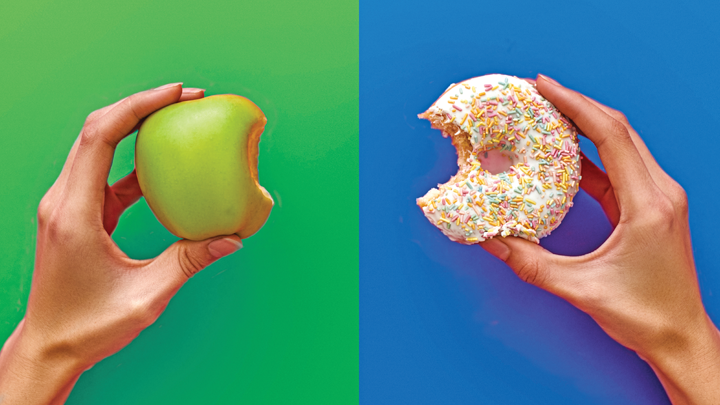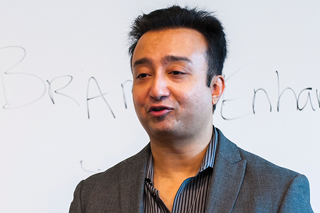University
Unseen Forces Play Role in Food Choices You Make

YOU GO OUT TO DINNER, ORDER AN APPETIZER and entrée and, on a special occasion, maybe a dessert. Pretty simple, right? Cut and dried. Well, think again. A lot of unseen forces come into play that determine how you pick your main course, how much you eat and even how much you will leave for a tip.
Feast on these food facts:
- If you’re in a noisy restaurant, like a sports bar or one with a live band, you are
less likely to make a healthy food choice. In a quiet eatery, you probably will choose
the salad over the deep-fried chicken livers. You also will probably choose a healthy
dinner in a brightly lit room more than in a dimly lit one.
- You eat less with a fork than with a spoon.
- Prolonged exposure (more than two minutes) to the smell of cookies may directly satisfy
your hunger cravings for unhealthy foods. You don’t have to eat anything. You just
have to sniff it.
- Food tastes better if you’re eating it while sitting down. Conversely, eating the
same food while standing just doesn’t satisfy. It has to do with below-the-surface
stress levels the body undergoes while standing.
- The color of the little billfold that contains your check at the end of the meal may have more to do with how much you plunk down in a gratuity than service or quality of food. If the billfold is gold in color, you’ll probably round up in your tip calculations. If your bill is in an aluminum tray, you may under-tip your server.

These are not just curious observations or culinary legends. They all are the findings of rigorous research conducted by Dipayan Biswas, a noted sensory marketing professor in the USF Muma College of Business. For 15 years, Biswas has been looking at the underlying reasons people do what they do in restaurants, grocery stores and other retail outlets hawking food and drink. His work has been published not only in top-tier, international journals but it also has appeared in media across the United States and around the world, stretching from Europe to South America to Asia.
“Dr. Biswas’ work has contributed greatly to the global reputation of USF,” says Doug Hughes, chair of the Muma College of Business marketing department. “USF is very privileged to have Dr. Biswas as a faculty member. His impressive accomplishments on the world stage bring tremendous credit to USF.”
Hidden persuaders
Sensory marketing – and all its closely held secrets – has appealed to Biswas since he earned a doctorate in 2004 from the University of California, Irvine.
“Right after finishing my PhD, I started exploring topics that would get me passionate and excited,” he says. “After reading some of the work in the areas of sensory perceptions and food consumption, I really got into it.”
The Exide Professor of Business has a long list of awards that includes best papers in a number of marketing conferences and outstanding editor and educator awards, and he is a recipient of research grants from the U.S. Department of Agriculture and the National Science Foundation.
His work is relatable not only to other sensory marketing researchers, but to the general public as well. His findings are particularly impactful for owners and managers of establishments that sell or serve food.
“I think several of my research topics have had deep impact,” Biswas says. “However, if we go with statistics, my paper in the Journal of Marketing Research in 2017, on the effects of ambient light on food choices, has had the deepest impact. This research also received wide media coverage and influenced business practices.”
That research found that people who ordered in bright rooms were 24 percent more likely to choose nutritious foods, like salads, vegetables and grilled fish, rather than those who ordered in darker establishments (think chicken wings, loaded baked potatoes, chocolate lava cake). On average, people in darkened restaurants ordered 39 percent more calories than those in lighter places. Bright lighting, Biswas found, may nudge you toward healthier foods by keeping your brain alert.
It would seem gathering this type of information would be interesting, intriguing and fun. Well, he says, it is. But picking his favorite project, “is like picking out a favorite child.”
The color and scent made me do it
“Perhaps the two most fun projects were my 2019 paper that examined effects of ambient scent and a current working paper on effects of ambient color,” he says. “Both these research projects entailed running several field studies, including studies at school cafeterias, which can be challenging and fun at the same time.
“They were especially fun because they had direct relevance for retail stores and restaurants,” he says. “And it was interesting to observe significant changes in customer purchase behavior just by changing the ambient scent or color.”
Sensory marketing may be a touchy subject among some. Critics say there is something not quite right about nudging a consumer into a certain direction through subliminal coaxing, while retailers are always looking for the edge that gives them a leg up on the competition.
“There are legitimate concerns about the ethical and moral aspects of companies manipulating consumers non-consciously, using sensory cues,” Biswas says. “But this is one reason why I make my research so accessible to the public, so that consumers can get insights into and be aware of this phenomenon.”
In addition to his seemingly never-ending research projects, Biswas teaches an undergraduate-level course in basic marketing, a graduate-level course in brand management and a doctoral-level course in sensory marketing.
Can he ever turn off the critical eye when dining out? Not really. Going out to eat, he studies the ambient color, listens to the noise and checks the menu to see what food is displayed and where. Displaying healthy food to the left of an unhealthy option, it turns out, can influence the selection and consumption volume of the healthier choice.
Occasionally, Biswas may let the manager/owner know about some of his findings.
Reactions to advice
“There have been instances where I provided friendly, informal feedback to a restaurant or a retail outlet if they have things messed up on the sensory combinations,” he says. “Most managers tend to like such helpful feedback.”
Often when business is off, sensory marketing provides a simple, cost-effective solution. Biswas cites two examples:
“We were called to look into a retail store at a major airport,” he says. “Its sales were low and we ran some field experiments involving effects of ambient light and music and came up with some answers. After implementing the changes suggested in the study, the store’s management was able to see significant increases in their sales.
“Another instance involves a major hotel chain,” he says. “We ran a large-scale field study with different color combinations on their website and they saw a significant increase in conversion rates (proportion of visitors to the website actually clicking to make the booking). And so, they immediately implemented the findings of my research in terms of color contrasts on their website and business was on the upswing.”
Not only is his work known far and wide, it also takes place far and wide. He has conducted field studies and collected data in several companies across multiple countries, including Germany, Sweden, France, India, the Netherlands and Norway. His findings have been shared through the New York Times, all the major television and cable networks, U.S. News & World Report, the Daily Mail and the BBC in the United Kingdom as well as a series of scientific and health magazines.
G.J. de Vreede, associate dean for research and professional programs with the Muma College of Business, says Biswas is “an outstanding researcher.”
“He is a wonderful international representative of the USF research brand,” de Vreede says “His work on sensory marketing is world famous. He is an enthusiastic ambassador of USF in general and the Muma College of Business in particular.
“His outstanding research has a global impact as well,” the associate dean says. “As the issues he studies are universal, it is not surprising that his work has been published and recognized around the globe.”
- Keithe Morelli ’78 | Muma College of Business